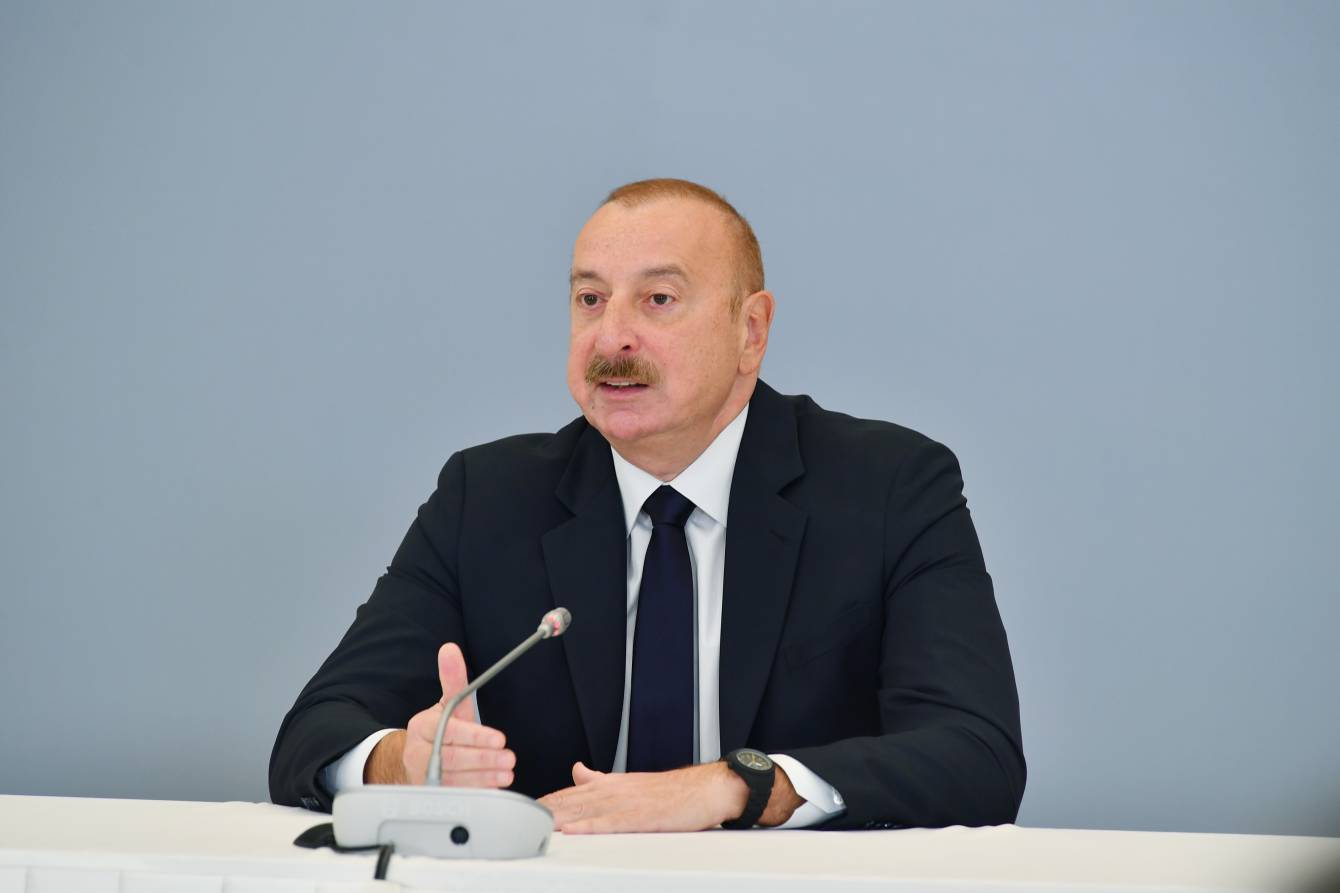The cross-country railroad in Azerbaijan, connecting Baku with the Georgian border on the country’s far west, is fully reconstructed to enable faster freight supplies, President Ilham Aliyev said, detailing his efforts to facilitate and maximize the East-West Middle Corridor trade and transport route’s operation.
The remarks came as the President attended the “Karabakh: Back Home After 30 Years. Accomplishments and Challenges” Forum in Baku on Wednesday.
“Now the train has a speed of 120 km/hr, which is faster in comparison with several years ago (50-60 km/hr)," he said, referring to the Baku-Tbilisi-Kars (BTK) railroad.
According to him, the government of Azerbaijan is not just satisfied with domestic railroad reconstruction projects, and invests in the expansion of the BTK route in neighboring Georgia.
“At the same time, the expansion of a Georgian segment of the Baku-Tbilisi-Kars railroad also will be finished in a month or two. It is again 100% Azerbaijani investment, more than 100 million US dollars. [The capacity] of that segment will be expanded from 1 million to 5 million tons maximum in a couple of months,” he noted.
BTK is an integral part of the East-West Middle Corridor connecting China with Europe.
The 829-kilometer-long BTK line is a highly efficient alternative route to reach the European marketplace. The BTK links Azerbaijan’s railway network to the railroad grid of Georgia and Türkiye and enables an easier and faster rail connection between China, Central Asia, and Europe.
The BTK railroad cuts the overland journey between China and Europe to 15 days instead of 25-45, making it twice as fast as sea transport and less than half the price of air travel. In its full swing, annual cargo deliveries on the line will reportedly reach 17 million tons.
Azerbaijan Railways Company (ADY) has reported that around 1.5 million tons of cargo was transported via BTK railway line from 2017-2022.
President Aliyev also commented on the restoration of a direct connection between the Azerbaijani mainland and the country’s southwestern Nakhchivan exclave.
He said the initial plans for the resumption of this connectivity line addressed cooperation with Armenia, which should have allowed the route’s transit through its territory.
“Also a road, which will go through the liberated territories, particularly through Zangilan, which is already there. We had a plan to continue this road through Armenia, but Armenia refused it. So, we agreed with the Iranian side, and we're already building a bridge for cars and then a bridge for trains to bypass Armenia and to build about 50 kilometers railroad on the southern bank of the Araz River,” President Aliyev stated.
“Then, it enters Nakhchivan and there'll be a connection with the Turkish railroad system. We were informed by the Turkish side that the Kars-Nakhchivan railroad is also planned to be built. So, it will be another extension of the Middle Corridor - one goes through Georgia to Kars and to Mediterranean ports, and another goes through Zangilan, Iran, Nakhchivan, and again Türkiye. So, this increases the physical capacity.”
The Zangilan-Iran-Nakhchivan railroad will be connected with the Turkish railway grid enabling an all-new East-West Middle Corridor connectivity option. The Middle Corridor is economical and faster compared to the Northern Corridor as a trade route between Europe and Asia and shrinks the travel distance by 2,000 kilometers. The multimodal land and sea transport route stretches from China through Kazakhstan, Uzbekistan and Turkmenistan, and, across the Caspian Sea through Azerbaijan and Georgia to the Black Sea and Türkiye.
The route consists of about 4,250 km of rail lines and about 500 km of seaway. The ultimate destination of the corridor is the European marketplace via Türkiye and the Black Sea.
The Middle Corridor also runs through more favorable climate conditions and shortens the travel time by 15 days compared to the sea route. Furthermore, the Middle Corridor offers great opportunities for cargo traffic in Asia so that the loads can reach the Middle East, North Africa and the Mediterranean region by integrating the port connections in Türkiye.
If used effectively, the Middle Corridor is expected to create important economic opportunities, enabling South Caucasian and Central Asian countries to benefit from China-Europe trade, which is valued at $600 billion annually. In particular, the establishment of logistical centers and free trade zones at the ports of Azerbaijan, Kazakhstan and Turkmenistan will facilitate the development and deepening of Trans-Caspian cooperation.
President Aliyev said the stakeholders need to combine efforts to make the Middle Corridor more commercially attractive.
“For that purpose, we already created a very efficient cooperation format between Azerbaijan, Georgia, Kazakhstan and Türkiye. I think that if other countries of Central Asia, particularly Uzbekistan, would consider joining the format, it will be only better for all of us. This really is a new map - new transportation map of Eurasia with great potential.”







 Azerbaijan and Armenia started the process of demarcation of their border on Tuesday, with the installation of the first border markers based on ge...
Azerbaijan and Armenia started the process of demarcation of their border on Tuesday, with the installation of the first border markers based on ge...
 Armenian sappers commenced on Monday mine-clearance operations in the territories adjacent to the Saint Mary Church in village of Voskepar (Armenia...
Armenian sappers commenced on Monday mine-clearance operations in the territories adjacent to the Saint Mary Church in village of Voskepar (Armenia...
 As the conflict between Ukraine and Russia escalates, the strategic importance of Kharkiv, Ukraine's second-largest city, has come sharply into focus.
As the conflict between Ukraine and Russia escalates, the strategic importance of Kharkiv, Ukraine's second-largest city, has come sharply into focus.
 President Aliyev emphasized the critical role of the North-South Transport Corridor in fostering transport cooperation between Azerbaijan and Russi...
President Aliyev emphasized the critical role of the North-South Transport Corridor in fostering transport cooperation between Azerbaijan and Russi...



